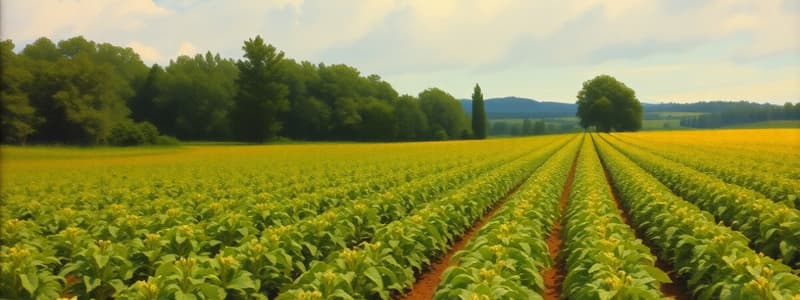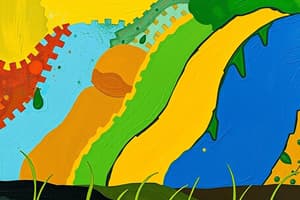Podcast
Questions and Answers
Which of the following is NOT a primary goal of agronomy?
Which of the following is NOT a primary goal of agronomy?
- Developing new synthetic pesticides for crop protection (correct)
- Producing plants for food, fuel, and fiber
- Minimizing the environmental impact of agriculture
- Improving crop yields and quality
A farmer notices consistently low yields in a field despite adequate fertilization. Which factor influencing crop production should be investigated FIRST?
A farmer notices consistently low yields in a field despite adequate fertilization. Which factor influencing crop production should be investigated FIRST?
- Selection of appropriate crops and varieties (correct)
- Pest and disease management
- Weed management
- Water management
To improve water infiltration and reduce soil erosion in a sloped field, which conservation tillage method would be MOST suitable?
To improve water infiltration and reduce soil erosion in a sloped field, which conservation tillage method would be MOST suitable?
- No-till
- Conventional tillage
- Reduced tillage
- Ridge tillage (correct)
A farmer wants to implement a cover cropping strategy to suppress weeds, improve soil health, and add nitrogen to the soil. Which combination of cover crops would be MOST effective?
A farmer wants to implement a cover cropping strategy to suppress weeds, improve soil health, and add nitrogen to the soil. Which combination of cover crops would be MOST effective?
A farmer observes an increase in a specific pest population despite regular pesticide applications. What IPM strategy should be prioritized to address this issue?
A farmer observes an increase in a specific pest population despite regular pesticide applications. What IPM strategy should be prioritized to address this issue?
How does crop rotation contribute to sustainable farming by balancing nutrient levels in the soil?
How does crop rotation contribute to sustainable farming by balancing nutrient levels in the soil?
What is the primary benefit of integrating trees and shrubs into agricultural systems through agroforestry, regarding environmental sustainability?
What is the primary benefit of integrating trees and shrubs into agricultural systems through agroforestry, regarding environmental sustainability?
Which of the following water management techniques is MOST effective for conserving water in an arid region with limited rainfall?
Which of the following water management techniques is MOST effective for conserving water in an arid region with limited rainfall?
How does reducing tillage contribute to soil health improvement, and what is its long-term impact on agricultural sustainability?
How does reducing tillage contribute to soil health improvement, and what is its long-term impact on agricultural sustainability?
In the context of precision agriculture, how do technologies like GPS, sensors, and data analytics contribute to optimizing crop production and minimizing environmental impact?
In the context of precision agriculture, how do technologies like GPS, sensors, and data analytics contribute to optimizing crop production and minimizing environmental impact?
Flashcards
Agronomy
Agronomy
The science of producing and using plants for food, fuel, fiber, and land reclamation, focusing on improving crop yields, quality, and minimizing environmental impact.
Crop Production
Crop Production
Cultivating plants for human or animal use, influenced by crop selection, soil, water, nutrient, pest, disease, and weed management, plus harvesting and storage.
Sustainable Farming Practices
Sustainable Farming Practices
Farming in an environmentally sound, economically viable, and socially responsible manner, emphasizing soil health, water and energy conservation, and biodiversity.
Conservation Tillage
Conservation Tillage
Signup and view all the flashcards
Cover Cropping
Cover Cropping
Signup and view all the flashcards
Crop Rotation
Crop Rotation
Signup and view all the flashcards
Integrated Pest Management (IPM)
Integrated Pest Management (IPM)
Signup and view all the flashcards
Precision Agriculture
Precision Agriculture
Signup and view all the flashcards
Organic Farming
Organic Farming
Signup and view all the flashcards
Agroforestry
Agroforestry
Signup and view all the flashcards
Study Notes
- Agronomy is the science and technology of producing and using plants for food, fuel, fiber, and land reclamation.
- It encompasses various aspects of crop production and soil management.
- Agronomy focuses on improving crop yields and quality.
- Agronomy aims to minimize the environmental impact of agriculture.
Crop Production Principles
- Crop production involves cultivating plants for human or animal use.
- Key factors:
- Selection of appropriate crops and varieties should be based on environmental conditions, market demand, and resource availability.
- Soil management is essential to providing plants with nutrients, water, and physical support.
- Soil management practices include tillage, fertilization, irrigation, and drainage.
- Water is essential for plant growth.
- Water management includes irrigation and drainage.
- Plants require essential nutrients for growth and development.
- Nutrient management involves supplying the necessary nutrients through fertilization and crop rotation.
- Pests and diseases can significantly reduce crop yields and quality.
- Pest and disease management strategies include integrated pest management (IPM), crop rotation, resistant varieties, sanitation and timely application of pesticides.
- Weeds compete with crops for resources.
- Weed management includes herbicides, cultivation, crop rotation, and cover crops.
- Proper harvesting and storage techniques are essential for maintaining crop quality and minimizing losses.
Sustainable Farming Practices
- Sustainable farming produces food and fiber in an environmentally sound manner, ensuring economic viability and social responsibility.
- Key principles:
- Maintaining and improving soil health is essential for long-term productivity and environmental sustainability, through:
- Conservation tillage, cover cropping, crop rotation, composting, and organic amendments
- Water is a limited resource.
- Water conservation includes irrigation management, rainwater harvesting, and drought-resistant crops.
- Sustainable nutrient management minimizes nutrient losses and protects water quality.
- Includes precision fertilization, slow-release fertilizers, and cover cropping.
- Sustainable pest and disease management minimizes synthetic pesticides and protects beneficial organisms, through:
- Integrated pest management (IPM), crop rotation, resistant varieties, and biological control
- Promoting biodiversity maintains ecosystem health and resilience, through:
- Crop diversification, habitat conservation, and agroforestry
- Reducing energy consumption mitigates climate change, through:
- Efficient irrigation systems, reduced tillage, and renewable energy sources
- Sustainable waste management minimizes pollution and conserves resources, through:
- Composting, anaerobic digestion, recycling, and responsible disposal
- Maintaining and improving soil health is essential for long-term productivity and environmental sustainability, through:
Conservation Tillage
- Conservation tillage reduces soil erosion, improves water infiltration and maintains soil organic matter.
- Types of conservation tillage:
- No-till farming involves planting crops directly into the residue of the previous crop, minimizing soil disturbance.
- Reduced tillage minimizes the number of tillage operations, leaving crop residue on the soil surface.
- Ridge tillage involves planting crops on ridges, leaving furrows for water drainage.
Cover Cropping
- Cover crops protect and improve the soil, and are not harvested for sale.
- Benefits include:
- Reduced soil erosion, improved soil health, increased water infiltration, weed suppression, and nutrient cycling
- Common cover crops:
- Legumes fix nitrogen in the soil.
- Grasses improve soil structure.
- Brassicas suppress weeds and pests.
Crop Rotation
- Crop rotation involves planting different crops in a sequence.
- Crop rotation improves soil health, reduces pest and disease problems, and can balance nutrient levels in the soil.
Integrated Pest Management (IPM)
- IPM is a comprehensive approach to pest management.
- IPM uses a combination of strategies to control pests and minimizes the use of synthetic pesticides.
- IPM strategies:
- Monitoring pest populations, using cultural practices to prevent pest problems, introducing biological control agents, and applying pesticides only when necessary
Precision Agriculture
- Precision agriculture uses technology to optimize crop production.
- Technologies:
- GPS, sensors, drones, and data analytics
- Precision agriculture can improve yields, reduce input costs, and minimize environmental impact.
Organic Farming
- Organic farming prohibits synthetic fertilizers and pesticides.
- Organic farming uses natural methods for soil fertility and pest control.
- Organic farming practices:
- Crop rotation, Composting, Cover cropping, Biological pest control
Agroforestry
- Agroforestry integrates trees and shrubs into agricultural systems.
- Agroforestry provides multiple benefits:
- Soil conservation, water conservation, carbon sequestration, biodiversity enhancement, and income diversification
Water Management Techniques
- Efficient irrigation systems:
- Drip irrigation delivers water directly to the roots of plants.
- Sprinkler irrigation distributes water over the entire field.
- Rainwater harvesting collects and stores rainwater for later use.
- Drought-resistant crops are adapted to dry conditions.
Soil Health Improvement
- Adding organic matter:
- Compost improves soil structure and fertility.
- Manure adds nutrients to the soil.
- Reducing tillage minimizes soil disturbance.
- Crop rotation improves soil health.
- Cover cropping protects the soil and adds organic matter.
Studying That Suits You
Use AI to generate personalized quizzes and flashcards to suit your learning preferences.




